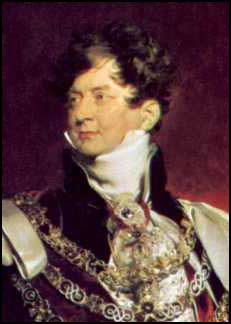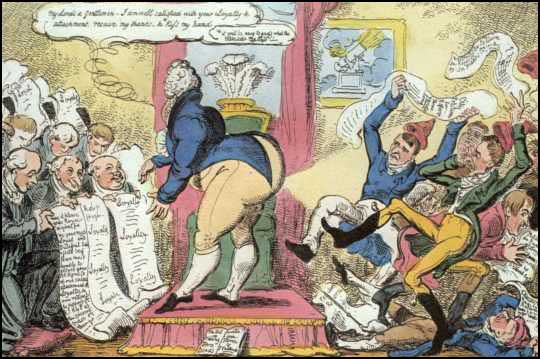By the 1780s the Prince of Wales had become a gambler, a
womanizer and a heavy drinker. He was deeply in debt and when Parliament agreed
to increase his allowance, George III remarked that it was "a shameful
squandering of public money to gratify the passions of an ill-advised young
man."
The Prince of Wales continued to overspend and by
1795 he had debts of £650,000. In an effort to persuade Parliament to pay off
his debts, George IV agreed to marry his cousin, Caroline of
Brunswick. After the birth of a daughter, Princess
Charlotte, on 7th January 1796, the couple lived apart.
In 1811 King George III suffered another bout of insanity. He was no longer able to
continue with his royal duties and the Prince of Wales was
appointed regent. For years the Prince of Wales had been making promises to the
Whigs that he would favor their political party when he replaced his Tory
father. However, this did not happen, and he quickly became an ultra Tory
supporting the policies of Lord
Liverpool and his government.
In his youth the Prince of Wales agreed with his friend Charles
Fox about the unfairness of the laws that
discriminated against Roman Catholics and Protestant
Nonconformists. Once in power George IV changed his views and became a strong
opponent of Catholic
Emancipation. He also abandoned his support for
those Whigs who
were arguing for parliamentary reform.
The Prince of Wales was impressed by the work of the architect, John
Nash. He commissioned him to design Regent's Park and its environs of curved
terraces. He also arranged for Nash to create Buckingham
Palace out of Buckingham House and the
rebuilding of the Royal
Pavilion at Brighton.
On the death of his father in 1820 George became king. Caroline of
Brunswick returned
to England to claim her rights as Queen. George IV persuaded Lord
Liverpool and his government to bring in an Act of parliament to deprive her
of the title Queen and to declare the marriage "for ever wholly dissolved,
annulled and made void". The Whigs
opposed the measure and their were
public demonstrations against the new king.
Queen Caroline appeared at George IV's coronation
but she was turned away from the doors of Westminster Abbey. This resulted in
further public demonstrations but this came to an end when Caroline died
suddenly on 7th. of August, 1821.
George IV was the antithesis of his father:
conservative in his infrequent political involvement and licentious in affairs
of the heart. He was a patron of the arts who left many wonderful artifacts for
posterity. He had his father's immense book collection donated as the foundation
of the British Museum Library and his penchant for building projects inspired
the "Regency" style of architecture.
George IV was an enigma: bright, witty and able on the one
hand, indolent, spoiled, and lazy on the other. The Duke of Wellington described
him as such: "He was the most extraordinary compound of talent, wit,
buffoonery, obstinacy, and good feelings, in short, a medley of the most
opposite qualities, with a great preponderance of good - that I ever saw in any
character in my life."
George IV's indulgent lifestyle seriously damaged his health. By the 1820s he was
extremely overweight and was addicted to both alcohol and laudanum. George
IV also began showing signs of insanity. He told people that he had
been a soldier and insisted he had fought at the Battle
of Waterloo. The king became more and more a recluse at Windsor
Castle and eventually died on June 26, 1830 after a series of strokes brought on
by a hemorrhage in his stomach.

